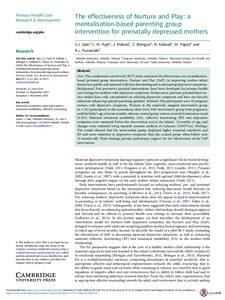The effectiveness of Nurture and Play: a mentalisation-based parenting group intervention for prenatally depressed mothers
S.J. Salo; M.Flykt; J. Mäkelä; Z. Biringen; M. Kalland; M. Pajulo; R.L. Punamäki
The effectiveness of Nurture and Play: a mentalisation-based parenting group intervention for prenatally depressed mothers
S.J. Salo
M.Flykt
J. Mäkelä
Z. Biringen
M. Kalland
M. Pajulo
R.L. Punamäki
CAMBRIDGE UNIV PRESS
Julkaisun pysyvä osoite on:
https://urn.fi/URN:NBN:fi-fe2021042823088
https://urn.fi/URN:NBN:fi-fe2021042823088
Tiivistelmä
Aim: This randomised control trial (RCT) study examined the effectiveness of a mentalisation-based perinatal group intervention, Nurture and Play (NaP), in improving mother-infant interaction quality and maternal reflective functioning and in decreasing depressive symptoms.
Background: Few preventive prenatal interventions have been developed for primary health care settings for mothers with depressive symptoms. Furthermore, previous prenatal intervention studies have only concentrated on reducing depressive symptoms and have not directly addressed enhancing optimal parenting qualities.
Methods: The participants were 45 pregnant women with depressive symptoms. Women in the randomly assigned intervention group (n = 24) participated in the manualised, short-term NaP intervention group from pregnancy until the baby's age of seven months, whereas control group women received treatment as usual (TAU). Maternal emotional availability (EA), reflective functioning (RF) and depressive symptoms were measured before the intervention and at the infants' 12 months of age, and changes were evaluated using repeated measure analyses of variances (ANOVAs). Findings: The results showed that the intervention group displayed higher maternal sensitivity and RF and more reduction in depressive symptoms than the control group when babies were 12 months old. These findings provide preliminary support for the effectiveness of the NaP intervention.
Kokoelmat
- Rinnakkaistallenteet [27094]
